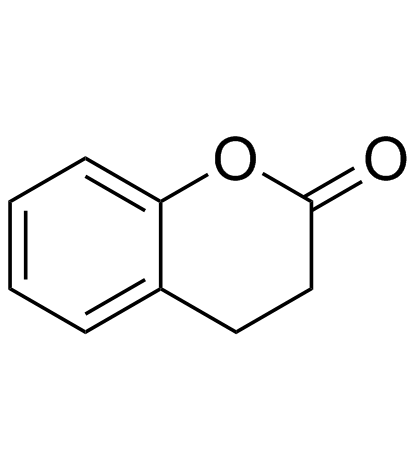119-84-6
| Name | 3,4-dihydrocoumarin |
|---|---|
| Synonyms |
Dihydrocoumarin
MFCD00006881 2-Chromanone EINECS 204-354-9 2H-1-Benzopyran-2-one, 3,4-dihydro- 3,4-Dihydro-1-benzopyran-2-one,Benzodihydropyrone,Hydrocou 3,4-dihydrochromen-2-one 3,4-Dihydrocoumarin Hydrocoumarin chroman-2-one |
| Description | Dihydrocoumarin is a compound found in Melilotus officinalis. Dihydrocoumarin is a yeast Sir2p inhibitor. Dihydrocoumarin also inhibits human SIRT1 and SIRT2 with IC50s of 208 μM and 295 μM, respectively[1]. |
|---|---|
| Related Catalog | |
| Target |
hSIRT1:208 μM (IC50) hSIRT2:295 μM (IC50) |
| In Vitro | Dihydrocoumarin induces a concentration-dependent inhibition of SIRT1 (IC50 of 208 μM) in an in vitro enzymatic assay. A decrease in SIRT1 deacetylase activity is observed even at micromolar doses (85±5.8 and 73±13.7% activity at 1.6 μM and 8 μM, respectively). The microtubule SIRT2 deacetylase is also inhibited with a similar dose dependency (IC50 of 295 μM)[1]. Dihydrocoumarin (1-5 mM) increases cytotoxicity in the TK6 cell line in a dose-dependent manner following a 24-h exposure. Dihydrocoumarin (1-5 mM) increases apoptosis in a dose-dependent manner in the TK6 cell line at the 6-h time point. A 5-mM dose of Dihydrocoumarin increases apoptosis at the 6-h time point in the TK6 cell line[1]. Dihydrocoumarin (1-5 mM) increases p53 lysine 373 and 382 acetylation in a dose-dependent manner in the TK6 cell line following a 24-h exposure period[1]. |
| References |
| Density | 1.2±0.1 g/cm3 |
|---|---|
| Boiling Point | 272.0±15.0 °C at 760 mmHg |
| Melting Point | 24-25 °C(lit.) |
| Molecular Formula | C9H8O2 |
| Molecular Weight | 148.159 |
| Flash Point | 108.4±17.8 °C |
| Exact Mass | 148.052429 |
| PSA | 26.30000 |
| LogP | 1.80 |
| Vapour Pressure | 0.0±0.6 mmHg at 25°C |
| Index of Refraction | 1.562 |
| Water Solubility | insoluble |
CHEMICAL IDENTIFICATION
HEALTH HAZARD DATAACUTE TOXICITY DATA
|
| Symbol |

GHS07 |
|---|---|
| Signal Word | Warning |
| Hazard Statements | H302-H315-H319-H335 |
| Precautionary Statements | P261-P305 + P351 + P338 |
| Personal Protective Equipment | Eyeshields;Faceshields;full-face respirator (US);Gloves;multi-purpose combination respirator cartridge (US);type ABEK (EN14387) respirator filter |
| Hazard Codes | Xn:Harmful; |
| Risk Phrases | R22;R36/37/38 |
| Safety Phrases | S26-S36 |
| RIDADR | NONH for all modes of transport |
| WGK Germany | 3 |
| RTECS | MW5775000 |
| HS Code | 29322980 |
| HS Code | 2932209090 |
|---|---|
| Summary | 2932209090. other lactones. VAT:17.0%. Tax rebate rate:13.0%. . MFN tariff:6.5%. General tariff:20.0% |


